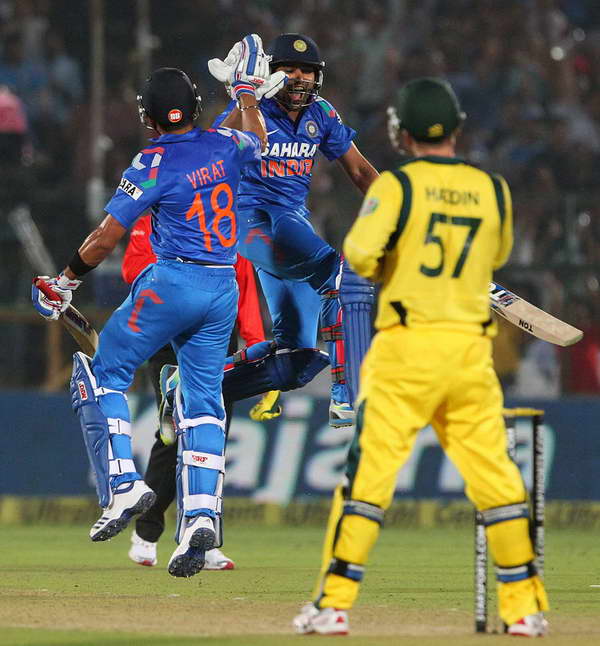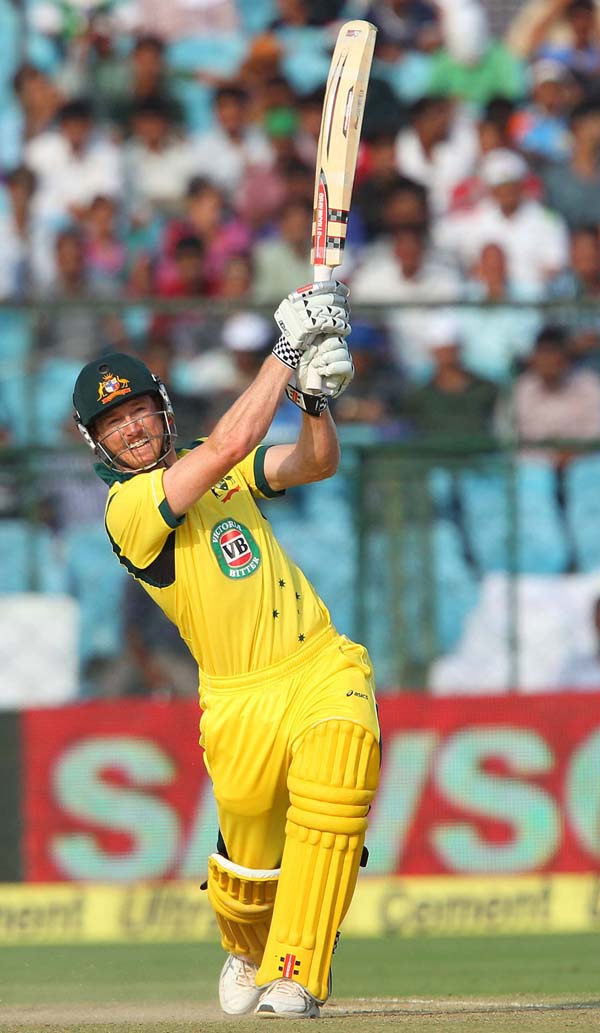Pragya Tiwari, Jaipur:;Oct 16, 2013, DHNS:
Young guns slam unbeaten tons as India chase down visitors’ mammoth 359/5
Virat Kohli and Rohit Sharma showed just why one should never underestimate the calibre of Indian batsmen on home soil by scripting a sensational chase of Australia’s gigantic 359/5 for an exciting nine-wicket victory in the second one-day international at the Sawai Man Singh Stadium on Wednesday night.
It was the second highest run chase in the world behind South Africa’s overhaul of Australia’s 434 in Johannesburg in 2005-06. The victory also levelled the series 1-1 after visitors had won the first ODI in Pune.
Few, though, would have given India a chance. But the ferocity with which Kohli (100 n.o., 52b, 8×4, 7×6) batted not only zoomed him to the history books for raising the fastest century by an Indian, surpassing Virender Sehwag, but also overshadowed the brilliant efforts of Rohit (141 n.o., 123b, 17×4, 4×6) and Shikhar Dhawan (95). Kohli’s was the seventh fastest ODI ton ever.
Such was the impact of Kohli’s knock that India ended their pursuit with 39 balls remaining.
The foundation was laid by 176-run opening stand between Rohit, who scored his third ODI century, and Dhawan, who was unlucky to miss his ton.
Dhawan especially batted with certain defiance he has come to be reckoned with. On a belter, he showed no hesitance in stepping out and going after the bowling, and Shane Watson faced the music when he was sent three successive boundaries in the ninth over.
Dhawan’s departure, caught behind off James Faulkner, brought Kohli to the middle and what followed was pure mayhem. With his terrific strokeplay, he ripped apart the formidable Australian attack, who could not find any bite from the track, supposed to aid the seamers.
Kohli’s innings also provided cushion to Rohit, who in the middle overs was hampered by cramps. Rohit’s innings was a continuation of his form in the Twenty20 formats, imbued with responsibility and controlled aggression. His hundred, was his first in three years in ODIs, and deservedly earned him the man of the match award.
The Australians could not be faulted if they had dreamt of pulling off 2-0 lead in the series here. Their batting was phenomenal after they asked Indians to field under blazing sun.
Australia’s innings was based on well-planned strategy of constructing the innings through strong partnerships. Never before in a one-day international the first five batsmen of any team had scored 50s and never before an Australian team racked up such a mammoth total on Indian soil.
The Indian bowlers, tempted by the greenish cover, resorted to bowling short but couldn’t be probing enough. They didn’t have the pace to trouble the batsmen and their wayward line only brought them at the receiving end of the Australian onslaught for the second straight time.
After a solid start by Aaron Finch (50) and Phil Hughes (83), the Australians innings gained momentum through the sensational batting from their captain George Bailey, whose brisk 96-run fourth-wicket stand with Glenn Maxwell helped them in compiling such high score.
Before that Shane Watson (59), the virtual home boy of Rajasthan Royals, played crucial innings at No. 3 to set the stage for an Australian run-fest.
He started with a boundary, a mistimed cut which flew through the slip and grew only menacing from there on. More significantly, Watson whipped the two Indian spinners — R Ashwin and Ravindra Jadeja — to kill any hopes of a fightback. But the way hosts rose to the occasion sent the spectators with fond memories of finest Indian batting.
Dhawan, Rohit propel India past 150
Jaipur: Only once has a target of 350-plus been chased successfully in an ODI, but India could not have asked for a better response from their openers as they looked to become the second side to do so. Shikhar Dhawan and Rohit Sharma racked up 173 by the halfway mark, keeping up comfortably with an asking-rate of above seven an over.
The duo began solidly against the fast bowlers, went through a short lull against the spinners before Dhawan responded with a flurry of boundaries that more than made up for the brief let-up. During his brief career, Dhawan has made sure he makes let-offs and good fortune count. He was put down on 18 off Clint McKay and survived a very close stumping appeal on 42 against Xavier Doherty. After both reprieves, he let loose a volley of imperious strokes.
He charged the fast bowlers, especially Shane Watson repeatedly, to power them through the covers. He pulled with confidence, and even the extra pace of Mitchell Johnson could not rein him in.
Rohit wasn’t as free-flowing but that did not take away from his contribution to the stand. He was strong through and over the covers against the quicks. It was he who broke who ended the fallow period of five overs for 18 runs against the spinners by stepping out and lifting Glenn Maxwell for six. Barring that sequence, Australia were never able to build any pressure, conceding boundaries regularly.
The only challenge in front of India now was whether the rest would be able to keep up with the frenetic pace the openers had set.
1st innings Australia 359 for 5 (Bailey 92*, Hughes 83) v India
Australia’s first three batsmen delivered the platform with three half-centuries and George Bailey and Glenn Maxwell savaged the already clueless India attack to catapult their side to their highest total in India. Roughed up by Aaron Finch, Phillip Hughes and Shane Watson, India’s bowlers leaked 96 in 8.3 overs against the fourth-wicket duo of Bailey and Maxwell, and 132 in the last ten overs. It was the first time the first five batsmen had made fifties in an ODI. Their bowlers’ failure meant India’s batsmen again faced a task they have never achieved before – chase 300-plus successfully against Australia.
It had taken the captain Bailey to hold the Australia innings together in the middle stage in the first ODI before a lower-order charge had pushed them just over 300. Today, there was no need of any such shepherding. Finch and Hughes put on 74 upfront, and Watson and Hughes motored to a century stand at more than run a ball before Maxwell and Bailey, in particular, shredded the bowlers at the death.
To describe the shots of the Australia batsmen in any great detail would be to miss the big picture. In this case, plain numbers suffice to show the effect they must have had on India’s bowlers. Australia hit 36 fours and 12 sixes, showing just how vulnerable a side like India, with an average attack and plenty of average fielders, are against the new ODI rules. However, it is hard to say whether one extra fielder outside the circle would have made a significant difference given the regularity, and severity, with which Australia found the gaps.
Seam or seam, right-arm or left-arm, there was nowhere to hide for any variety of bowler. Considering there was plenty of turn in the pitch, that was a harsh indictment of the spinners in particular. Ravindra Jadeja, R Ashwin and Yuvraj Singh dropped it short so frequently that turn was rendered immaterial. They conceded 157 in 22 overs for a solitary wicket, Hughes falling for 83 to his tormentor from the Test series earlier this year, Ashwin.
Hughes was the last of the top order to fall, in the 38th over, by which time Australia had gone past 200. Finch had imposed himself early while Hughes played himself in. It took a direct hit to send Finch back, but Watson came in and pulled the spinners’ long hops for boundaries to further raise the tempo.
India’s three seamers had already suffered, their sporadic attempts at trying to bounce Australia at medium-pace disappearing to the boundary, as did their length offerings.
But all the early suffering was to prove only the prelude to the late flood of punishment that Maxwell and Bailey were to subject them to. Maxwell casually swept Ashwin third ball for six over deep square leg. The floodgates had been creaking under pressure all the time, now the dam broke. Maxwell continued to swat spinner and seamer alike over the leg side before he was run out for 53 off 32.
Bailey effortlessly lifted the quicks straight down the ground. Soon he was lofting over extra cover, slogging over midwicket, and doing pretty much whatever he wished to do. India’s seamers remembered there was something called a yorker, but their attempts ended up as full tosses at the other end. Bailey moved into the 90s as he carved Ishant Sharma over point. The Australia captain had faced just 50 deliveries and could have gone on and on, but it was the final ball of the innings.
25 overs India 173 for 0 (Dhawan 93*, Rohit 62*) need another 187 runs to beat Australia 359 for 5 (Bailey 92*, Hughes 83)



